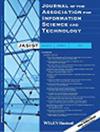Partial orders and measures for language preferences
Journal of the American Society for Information Science and Technology
Pub Date : 2000-10-01
DOI:10.1002/1097-4571(2000)9999:9999%3C::AID-ASI1014%3E3.0.CO;2-4
引用次数: 13
Abstract
Relative own-language preference depends on two parameters: the publication share of the language, and the self-citing rate. Openness of language L with respect to language J depends on three parameters: the publication share of language L, the publication share of language J, and the citation share of language J among all citations given by language L. It is shown that the relative own-language preference and the openness of one language with respect to another one, can be represented by a partial order. This partial order can be represented by a polygonal line (for the relative own-language preference) or a three-dimensional solid (for openness), somewhat in the same spirit as the Lorenz curve for concentration and evenness. Any function used to measure relative own-language preference or openness of one language with respect to another one should at least respect the corresponding partial orders. This is a minimum requirement for such measures. Depending on the use one wants to make of these measures other requirements become necessary. A logarithmic dependence on the language share(s) seems a natural additional requirement. This would correspond with the logarithmic behavior of psychophysical sensations. We give examples of normalized functions satisfying this additional requirement. It is further investigated if openness partial orders can lead to measures for relative own-language preference. The article ends with some examples related to the language use in some sociological journals.语言偏好的部分顺序和度量
相对自己的语言偏好取决于两个参数:语言的发表份额和自引用率。语言L相对于语言J的开放性取决于三个参数:语言L的发表份额、语言J的发表份额和语言J在语言L给出的所有引用中的引用份额。结果表明,一种语言相对于另一种语言的开放性和相对于另一种语言的相对自身语言偏好可以用偏序来表示。这种偏序可以用多边形线(对于相对自己的语言偏好)或三维立体(对于开放性)来表示,在某种程度上与洛伦兹曲线的集中和均匀性相同。任何用来衡量一种语言相对于另一种语言的相对偏好或开放性的函数都至少应该尊重相应的部分顺序。这是此类措施的最低要求。根据想要使用这些措施的不同,其他要求也变得必要。对语言共享的对数依赖似乎是一个自然的附加要求。这将与心理物理感觉的对数行为相对应。我们给出了满足这个附加要求的归一化函数的例子。本文进一步研究了开放偏序是否能导致相对自身语言偏好的测量。文章最后列举了一些社会学期刊上的语言使用实例。
本文章由计算机程序翻译,如有差异,请以英文原文为准。
求助全文
约1分钟内获得全文
求助全文
来源期刊
自引率
0.00%
发文量
0
审稿时长
3.5 months

 求助内容:
求助内容: 应助结果提醒方式:
应助结果提醒方式:


